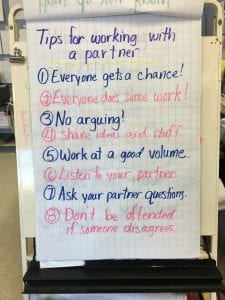The other day in a presentation someone asked why we are seeing so many self-regulation related problems now. What about our society has changed? That’s such an excellent question! Anecdotally, any teacher who has been around for a while can attest to the fact that we definitely do see a higher incidence of these now than we did 10 or 20 years ago. That leads us to ask one of Dr. Shanker’s favourite questions: Why? And why now? I am going to write about a couple of things that I think are really prevalent now, but weren’t 10 or 15 years go. I’m sorry it sounds like an assignment for a class, but I wanted to include some sources to back up what I am including. This isn’t just my opinion.
Technology and Kids: Part 1
In the fall, we all watched a video at a PD day that highlighted an experiment known as The Still Face Experiment. Basically, mom interacts with baby and everyone is happy. Mom stops interacting and holds her face still and baby is very unhappy. Go watch it again and think about how often we see parents interacting with their phone instead of their child. I was in line for a ride at Magic Kingdom recently and stood behind two brothers, about age 8 and 10, and they beat the crud out of each other for at least 15 minutes while mom used her phone to do I don’t know what. Maybe she was booking Fast Passes for something, which I get, but I think it illustrates how easy the phones can make it for parents to ignore their children. Even if parents are thinking the child is busy with their own thing, the parent isn’t interacting with the child. This means the child isn’t learning to read facial expressions and understand tone of voice, and lose out on chances to learn about the give and take of a conversation because the parent isn’t interacting with them. The child might actually be ignored to the point where they miss out on a chance to learn that their caregiver is meant to help them when they are upset. Their neural processes get all mixed up and instead of learning that something like a block tower falling down is easy to recover from, the falling block tower becomes a really huge deal that leads to a really huge reaction. Then one day that child is in kindergarten and someone else knocks his tower down and….well, you can picture it from there. In addition, spending a few minutes watching little kids in class with an iPad will show they can carry on a conversation without ever looking at the person they are speaking to. Even if you are limiting tablet time in class, you’ve likely seen students do this and know, like I do, that this is probably going on at home too. If you don’t believe me that this is a problem, check out this article from Psychology Today by psychotherapist Sean Grover.
Technology and kids: Part 2
Let’s get this out of the way right now: I am writing this while my children play games on the tablet and computer. The games and videos they are allowed to access are very limited. We don’t do violence around here! (Well, not counting brother vs. sister violence.) Every teacher reading this, from k-12, can talk about students who play a lot of violent, aggressive, fast paced video games. I once had a grade 2 child tell me his parents knew that “Rated M” means mature and they felt he was mature enough for “Grand Theft Auto”. Instead of explaining how this relates to self-regulation, I am going to link to an article by Dr. Stuart Shanker. I will give you this one quote:
“The problem here is that these games have a powerful effect on the limbic system and the brain stem: the mammalian and reptilian brains. Neither is equipped to distinguish between “game” and “reality”: between “real threat” and “make-believe”. The former is searching for predators or prey in exactly the same way that it would do in the wild, while the latter is primed to respond with an instant spurt of epinephrine and norepinephrine to increase heart rate and blood pressure: over and over and over. What’s more, these systems remain on high alert during sleep, which may be one of the reasons why we see Ivarrson’s results: that is, it takes some time for these primitive systems to register that the “danger” is past. And, of course, prolonged fight-or-flight has a blunting effect on the prefrontal systems that subserve appraisal, self-control, and prosocial behaviour.”
There is a lot more information the article, but even if there wasn’t, I feel like this is enough to say that the increased use of technology by humans of all ages is enough to help explain why we are seeing an uptick in the number of children who struggle to self-regulate. Remember “Pong”? I don’t either! I’m way too young. But nobody was shooting fast action assault rifles in Pong in 1984.
Here are a few blog posts and articles you can read if you’d like to think more about this:
Aviva Dunsiger, an ELK teacher, writes about using Dash and Dot in her class and the dysregulation that came with this activity.
And just because it’s important to think of both sides, here’s an article about how tech can be really useful as a regulation tool in the classroom.
One thing that is talked about in the book “Self-Reg” by Dr. Shanker is that an iPad might seem to regulate a child. It might seem to calm the child. But what happens when the iPad is taken away? Is this followed by a huge show of dysregulation? If it is, then this is not the tool for that child.
GET OUT!
There are whole books written about how important it is for humans to spend time outdoors. I think we can all agree that humans spend more time indoors now than in any previous generation. We work inside, we stay inside when it’s cold, we have a lot of fun stuff to do inside. We have busy, planned lives that involve jumping from activity to activity. We have regulations that keep children indoors when it is too hot or too cold. The more I am thinking about this the more I feel like I need to get my kids off their tech and outside. For the sake of time, I am going to link here to several articles you can read about this if you are thinking this might be something you’re wondering more about.
https://childmind.org/article/why-kids-need-to-spend-time-in-nature/ http://childnature.ca/forest-school-canada/
https://www.otffeo.on.ca/en/learning/tlc/report/take-me-outside-an-early-years-urbanrural-environmental-inquiry/
https://www.sciencedirect.com/science/article/pii/S2444866416301234
This is final one is a long read, but if you jump to page 22, you can read about the connection between outdoor time and mental health. https://lawson.ca/wp-content/uploads/2018/04/YE_Systematic_Review_Gifford.pdf
Final Thoughts
These aren’t all the reasons. But I think I have highlighted some things that are different now in our society than they were 10, 15 or more years ago.
A few weeks ago there was a show on CBC that was all over social media. A teacher talked about how violence in the classroom had effected her. Below is a link to the follow-up show. There is some information that fits with this post and helps to explain some of the “Why? Why now?” when we are trying to figure out all the difficulty with self-regulation we see in classrooms, and society.
https://www.cbc.ca/listen/shows/sunday-edition/segment/15681184?fbclid=IwAR1jlYmsXLpLHEMvviVaCj321L_NCJ1AeTB_5SfahlNrY2e3RLW4Y6dTcoI
Final, Final thoughts:
https://www.youtube.com/watch?time_continue=117&v=1XDVDyDJ3s0


